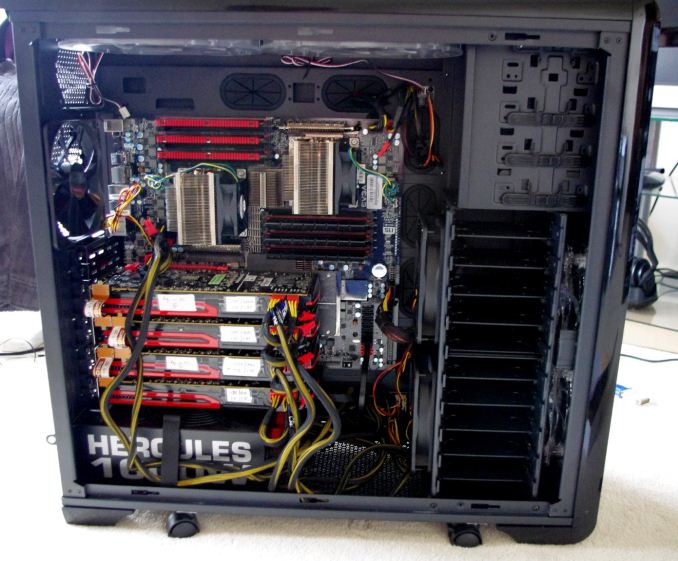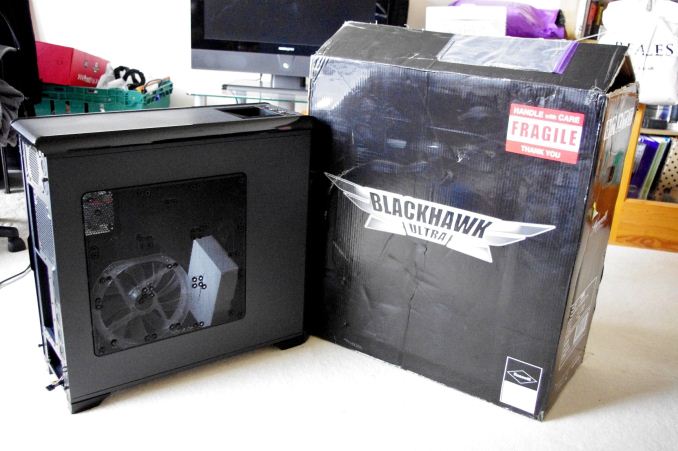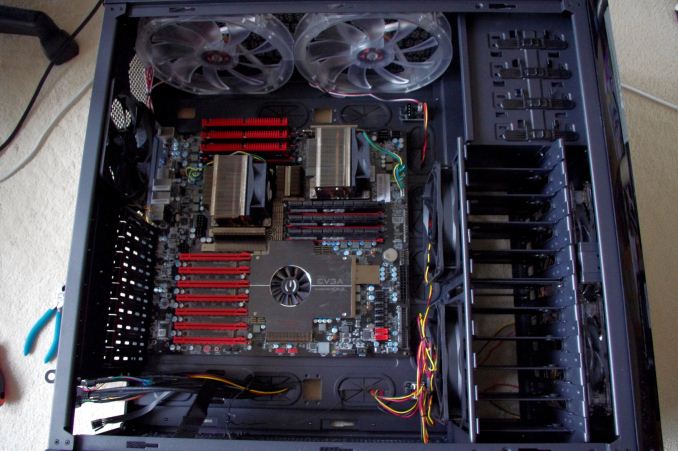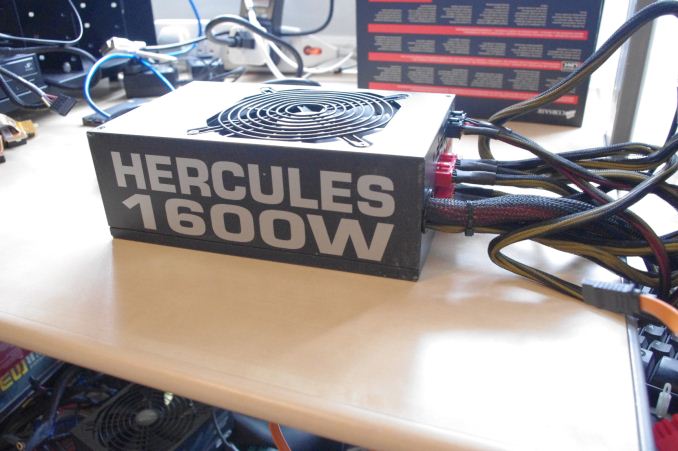Choosing a Gaming CPU: Single + Multi-GPU at 1440p, April 2013
by Ian Cutress on May 8, 2013 10:00 AM ESTTo start, we want to thank the many manufacturers who have donated kit for our test beds in order to make this review, along with many others, possible.
Thank you to OCZ for providing us with 1250W Gold Power Supplies.
Thank you to G.Skill for providing us with the memory kits.
Thank you to ASUS for providing us with the AMD GPUs and some IO Testing kit.
Thank you to ECS for providing us with the NVIDIA GPUs.
Thank you to Corsair for providing us with the Corsair H80i CLC.
Thank you to Rosewill for providing us with the 500W Platinum Power Supply for mITX testing, a BlackHawk Ultra, and 1600W Hercules PSU for extreme dual CPU + quad GPU testing, and RK-9100 keyboards.
Thank you to Gigabyte for providing us with the X5690 CPUs.
Also many thanks go to the manufacturers who over the years have provided review samples which contribute to this review.
Testing Methodology
In order to keep the testing fair, we set strict rules in place for each of these setups. For every new chipset, the SSD was formatted and a fresh installation of the OS was applied. The chipset drivers for the motherboard were installed, along with NVIDIA drivers then AMD drivers. The games were preinstalled on a second partition, but relinked to ensure they worked properly. The games were then tested as follows:
Metro 2033: Benchmark Mode, two runs of four scenes at 1440p, max settings. First run of four is discarded, average of second run is taken (minus outliers).
DiRT 3: Benchmark Mode, four runs of the first scene with 8 cars at 1440p, max settings. Average is taken.
Civilization V: One five minute run of the benchmark mode accessible at the command line, at 1440p and max settings. Results produced are total frames in sets of 60 seconds, average taken.
Sleeping Dogs: Using the Adrenaline benchmark software, four scenes at 1440p in Ultra settings. Average is taken.
If the platform was being used for the next CPU (e.g. Maximus V Formula, moving from FX-8150 to FX-8350), there's no need to reinstall. If the platform is changed for the next test, a full reinstall and setup takes place.
How to Read This Review
Due to the large number of different variables in our review, it is hard to accurately label each data point with all the information about that setup. It also stands to reason that just putting the CPU model is also a bad idea when the same CPU could be in two different motherboards with different GPU lane allocations. There is also the memory aspect to consider, as well as if a motherboard uses MCT at stock. Here is a set of labels correlating to configurations you will see in this review:
CPU[+][(CP)] (PCIe version – lane allocation to GPUs [PLX])
First is the name of the CPU, then an optional + identifier for MCT enabled motherboards. (CP) indicates we are dealing with a Bulldozer derived CPU and using the Core Parking updates. Inside the parentheses is the PCIe version of the lanes we are dealing with, along with the lane allocation to each GPU. The final flag is if a PLX chip is involved in lane allocation.
Thus, for example:
A10-5800K (2 – x16/x16): A10-5800K with two GPUs in PCIe 2.0 mode
A10-5800K (CP) (2 – x16/x16): A10-5800K using Core Parking updates with two GPUs in PCIe 2.0 mode
FX-8350K (2 – x16/x16/x8): FX-8350 with three GPUs in PCIe 2.0 mode
i7-3770K (3/2 – x8/x8 + x4): i7-3770K powering three GPUs in PCIe 3.0 but the third GPU is using the PCIe 2.0 x4 from the chipset
i7-3770K+ (3 – x16): i7-3770K (with MCT) powering one GPU in PCIe 3.0 mode
i7-3770K+ (3 – x8/x8/x8/x8 PLX): i7-3770K (with MCT) powering four GPUs in PCIe 3.0 via a PLX chip
Common Configuration Points
All the system setups below have the following consistent configurations points:
- A fresh install of Windows 7 Ultimate 64-bit
- Either an Intel Stock CPU Cooler, a Corsair H80i CLC or Thermalright TRUE Copper
- OCZ 1250W Gold ZX Series PSUs (Rosewill 1600W Hercules for The Beast)
- Up to 4x ASUS AMD HD 7970 GPUs, using Catalyst 13.1
- Up to 2x ECS NVIDIA GTX 580 GPUs, using GeForce WHQL 310.90
- SSD Boot Drives, either OCZ Vertex 3 128GB or Kingston HyperX 120GB
- LG GH22NS50 Optical Drives
- Open Test Beds, either a DimasTech V2.5 EasyHard or a CoolerMaster Test Lab
AMD Configurations
A6-3650 + Gigabyte A75-UD4H + 16GB DDR3-1866 8-10-10
A8-3850 + ASRock A75 Extreme6 + 16GB DDR3 1866 8-10-10
A8-5600K + Gigabyte F2A85-UP4 + 16GB DDR3-2133 9-10-10
A10-5800K + Gigabyte F2A85-UP4 + 16GB DDR3-2133 9-10-10
X2-555 BE + ASUS Crosshair V Formula + 16GB DDR3 1600 8-8-8
X4-960T + ASUS Crosshair V Formula + 16GB DDR3-1600 8-8-8
X6-1100T + ASUS Crosshair V Formula + 16GB DDR3-1600 8-8-8
FX-8150 + ASUS Crosshair V Formula + 16GB DDR3-2133 10-12-11
FX-8350 + ASUS Crosshair V Formula + 16GB DDR3-2133 9-11-10
FX-8150 + ASUS Crosshair V Formula + 16GB DDR3-2133 10-12-11 + CP
FX-8350 + ASUS Crosshair V Formula + 16GB DDR3-2133 9-11-10 + CP
Intel Configurations
E6400 + MSI i975X Platinum + 4GB DDR2-666 5-6-6
E6700 + ASUS P965 Commando + 4GB DDR2-666 4-5-5
Celeron G465 + ASUS Maximus V Formula + 16GB DDR3-2133 9-11-11
i5-2500K + ASUS Maximus V Formula + 16GB DDR3-2133 9-11-11
i7-2600K + ASUS Maximus V Formula + 16GB DDR3-2133 9-11-11
i3-3225 + ASUS Maximus V Formula + 16GB DDR3-2400 10-12-12
i7-3770K + Gigabyte Z77X-UP7 + 16GB DDR3-2133 9-11-11
i7-3770K + ASUS Maximus V Formula + 16GB DDR3-2400 9-11-11
i7-3770K + Gigabyte G1.Sniper M3 + 16GB DDR3-2400 9-11-11
i7-3930K + ASUS Rampage IV Extreme + 16GB DDR3-2133 10-12-12
i7-3960X + ASRock X79 Professional 16GB DDR3-2133 10-12-12
Xeon X5690 + EVGA SR-2 + 6GB DDR3 1333 6-7-7
2x Xeon X5690 + EVGA SR-2 + 9GB DDR3 1333 6-7-7
The Beast
The Beast is a special machine put together to help with the review as a result of various hardware coming into my possession all at the same time. The core of the system is an EVGA SR-2 motherboard, the best and last dual processor motherboard to deal with overclockable Xeon processors. This is paired with a couple of X5690 Xeon processors, the highest clocked Westmere Xeon that Intel offers, and many thanks to Gigabyte for loaning these to us for a pair of reviews. I went and purchased a pair of Intel Xeon socket 1567 coolers for the system, which have a 2U z-height restriction but are copper piped and cooled by powerful (and loud) delta fans. These provided enough cooling power to push the Xeons from 3.43GHz to 4.6GHz during some overclocking attempts, so are more than adequate for the job at hand (if you can put up with the noise).
Our system is paired with some high quality DDR3 Hyper memory, once famed for its overclocking prowess but due to frequent deaths from high voltage, is now relegated as a memory for overclockers. However at stock this memory performs great, often in the region of DDR3-2000 C7, so our memory kits are well primed for this setup.
Of course a full system is nothing without a case and power supply to help justify a build. With the motherboard being absolutely huge, no standard case would take it – only large cases designed for desktop-based server 2P motherboards are adequate. Luckily there is one case which is selling well, and Dustin reviewed recently – the Rosewill Blackhawk Ultra. Aside from the weight, this case had no issues with installing the motherboard; it could easily fit in another 10 HDDs, four optical bays, and any major GPU setup you could possibly think of – with plenty of fans just for good measure. Read Dustin’s review for a more thorough analysis, but I have some good shots of the system and motherboard installed for you:
Rosewill also has the perfect power supply for dealing with a dual processor, quad CrossFireX setup. First, consider how many connections this 2P setup needs – we have a normal 24-pin ATX connector for the motherboard, one 8-pin CPU power connector for each CPU, an additional 6-pin PCIe power connector for each CPU to provide extra power, another 6-pin PCIe power connector to provide power to the PCIe slots, and then two 6+2 PCIe power connectors for the GPUs. That makes 11 PCIe connectors needed in total, and this is alongside all the fans in the case and whatever SSD/ODD setup a user wants. The power supply used for this monster is the 1600W Hercules, rated 80PLUS Silver. With access to 16 PCIe connectors, the only way you might need any more is with a compute rig having seven single slot cards each needing two connectors. With the CPUs and GPUs both overclocked, our system was drawing almost 1500W at the wall (at a 240V source) under a high CPU+GPU load.
Using a 2P system as a desktop comes with its own set of issues, namely some CPU benchmarks not optimized for 2P, or in this case, some trouble getting some games to even work. It seems that the more money you can throw at a gaming system the more problems start to arise, but The Beast provides a nice comparison point when we look at high-end Ivy Bridge, Sandy Bridge-E and Piledriver processors in multiple-GPU setups.
Our first port of call with all our testing is CPU throughput analysis, using our regular motherboard review benchmarks.
































242 Comments
View All Comments
colonelclaw - Thursday, May 9, 2013 - link
Jarred, I would fully agree with banning any person who continually makes no contribution to the discussion. These comment sections often supply me with useful information, and can be read as a continuation of the article itself. Having to hunt for the valuable opinions amongst piles of cretins and idiots makes me want to go elsewhere.extide - Thursday, May 9, 2013 - link
Please ban him, and I would consider myself a pretty solidly Intel guy myself, but you have to be realistic. Sheesh!Blibbax - Thursday, May 9, 2013 - link
Ban him and anyone else remotely similar.duploxxx - Friday, May 10, 2013 - link
if all would start voting to ban this person there would be a huge amount or thread reply :)Jon Tseng - Wednesday, May 8, 2013 - link
Hmmm. So bottom line is my 2007-vintage QX6850 is perfectly good a 1080p so long as I get the a decent GPU.Bizarro state of affairs when a 6 year old CPU is perfectly happy running cutting edge games. Not sure if I should blame the rise of the GPU or the PS3/XBox360 for holding back gaming engines for so long!
TheInternal - Wednesday, May 8, 2013 - link
In games that are CPU limited (like Skyrim or Arkham Asylum), no. I continue to get the impression from both personal experience and articles/reviews like this that once you have "enough" CPU power, the biggest limiting factor is the GPU. "Enough" often seems to be a dual core operating at 3.0GHz, but newer titles and CPU bound titles continue to raise the bar.Azusis - Wednesday, May 8, 2013 - link
Agreed. Especially in multiplayer situations. Try running PlanetSide 2 or Natural Selection 2 with a core2quad like I do. It isn't pretty. But just about any other singleplayer game... sure, no problem.TheInternal - Wednesday, May 8, 2013 - link
So... these were all tested on a single monitor? Though the article has lots of interesting information, I'd argue that doing these tests on a three monitor 1440p setup would show much more useful information that consumers looking at these setups would be able to apply to their purchasing decisions. It's great to see more reviews on different CPU + multiple GPU configurations, as well as the limitations of such settings, but by limiting such tests to an increasingly unlikely usage scenario of a single monitor, the data becomes somewhat esoteric.Kristian Vättö - Wednesday, May 8, 2013 - link
Did you mean three 1080p monitors (i.e. 5760x1080) by any chance? 7680x1440 is a very, very rare setup especially for a gamer. For work purposes (e.g. graphics designer, video editor etc) it can be justified as the extra screen estate can increase productivity, but I've never seen a gamer with such setup (heck, the monitors alone will cost you close to $2000!). I'm not saying there aren't any but it's an extreme minority and I'm not sure if it's worth it to spend hours, even days, testing something that's completely irrelevant to most of our readers.Furthermore, while I agree that 5760x1080 tests would be useful, keep in mind that Ian already spend months doing this article. The testing time would pretty much double if you added a second monitor configuration as you'd have to run all tests on both configs. Maybe this is something Ian can add later? There is always the trouble of timing as if you start including every possible thing, your article will be waaay outdated when it's ready to be published.
TheInternal - Thursday, May 9, 2013 - link
I didn't mean three 1080p monitors, which does seem to be the "common" three monitor configuration I've seen most gamers going for (since it's cheap to do with 24" panels being under $200 a pop) My 27" S-IPS 2560x1440 panel cost about $300, so I'm not sure where you're getting the $2000 figure from... and if you spend $1500-$2000 on the graphics subsystem, why wouldn't you be spending at least half as much on the monitors?Most modern high-end graphics cards should be able to easily handle three 1080p monitors in a three card config... possibly a two card config... a round up like this would be much more useful to consumers if it did include such information... as well as show just how well the different CPU and GPU combos worked with multiple monitors.